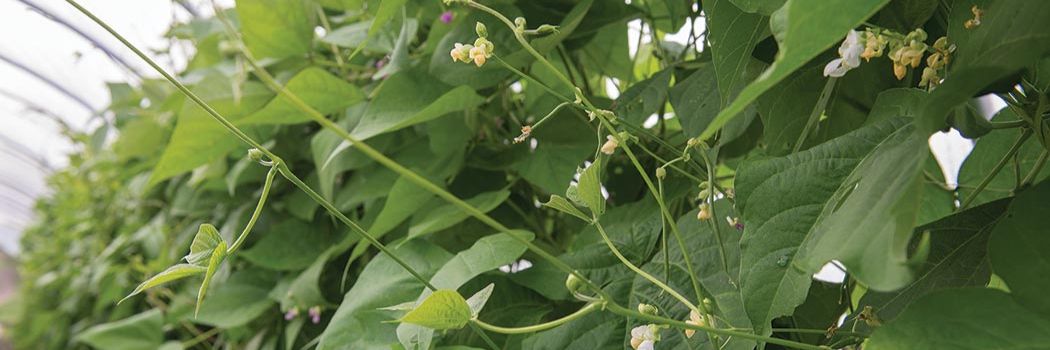- Types of Beans | Bean Basics From Johnny's Selected Seeds
- Bush Bean Varieties | Comparison Chart (PDF)
- Bean FAQs
- Bush Beans | Key Growing Information
- French Filet Beans | Key Growing Information
- Fresh Shell Beans | Key Growing Information
- Fava Bean | Key Growing Information
- Lima Bean | Key Growing Information
- Pole Bean | Key Growing Information
- Soybean | Key Growing Information
- Video: How to Grow Bush Beans • From Seed to Harvest
- Video: High-Value Crops & Varieties for Your Garden • Tutorial with Niki Jabbour
- How to Grow Pole Beans • From Seed to Harvest
- About Pole Beans | 4 Steps to Success: Select Varieties, Plant Seed & Set Up Your Trellis
- About Snap, String & Green Beans | Johnny's Selected Seeds
About Pole Beans
Pole Beans vs. Bush Beans: The Case for Pole Beans
Snap beans that grow on compact plants are typically called bush beans, while those that grow on tall, vining plants are called pole beans. Both types have a long, rich history of cultivation by many people and cultures, but pole beans more closely resemble the wild members of the species, compared to bush beans, which have been intentionally bred to have a “dwarf” plant. When trying to decide which type is right for you and your growing style, there are some factors to consider.
Advantages of pole beans over bush beans:
- Pole beans flavor have much better eating quality than even the best bush beans. Pole beans are sweeter and starchier, more tender, and tend to be slower to get tough and chewy.
- Pole beans offer a longer harvest window, as the larger plants produce beans for an extended period compared to the more determinate bush varieties. A pole bean planting that is regularly harvested should yield well for three weeks or so.
- Due to their more indeterminate growth habit, and the fact that pole beans grow vertically, pole beans generate higher yields in a similar footprint compared to bush beans.
- Because they are grown vertically, pole beans can be harvested with much less bending over—giving your back a break!
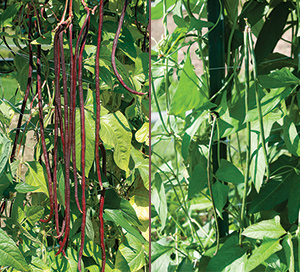
Disadvantages of pole beans over bush beans:
- The initial time and cost investment to grow pole beans is higher than it is for bush beans, due to the need to set up a trellis system.
- Pole beans generally mature a little later on average than bush beans do.
- Bush beans are better suited to accommodate a more concentrated harvest.
Selecting the Right Pole Bean Varieties For Your Needs • Flat Pod, Round Pod & Yard-Longs
Compared to bush beans, pole beans tend to offer a much more diverse assortment of types. In addition to your standard snap bean (Phaseolus vulgaris), there are yard-long beans (Vigna unguiculata), scarlet runner beans (Phaseolus coccineus), lima beans (Phaseolus lunatus) and more. Even within the snap bean type, there is a wide range of shapes, sizes, and colors!

Above: left to right: 'Fortex', 'Monte Gusto', 'Carminat', 'Northeaster', 'Seychelles', 'Helda', 'Cobra', 'Marvel of Venice', 'Red Noodle', 'Python'.
Flats
If you like sweet, tender, wide, Roma-type beans, then you will love our early-maturing organic option, 'Northeaster'.Rounds
If you like extra-long, slender beans, try our customer favorite, 'Fortex', which can be harvested at 7" as a filet bean, but even when allowed to grow up to 11" remains stringless and tender. 'Fortex' has far better eating quality than any bush bean.Yard-longs
Originating in the tropics and subtropics, yard-long beans are a group of heat-loving beans from a different genus and species (Vigna unguiculata) from bush (Phaseolus vulgaris) or lima beans (Phaseolus lunatus). These beans taste best when cooked. Try sweet and graceful 'Python', or eye-catching 'Red Noodle'.
Trellising
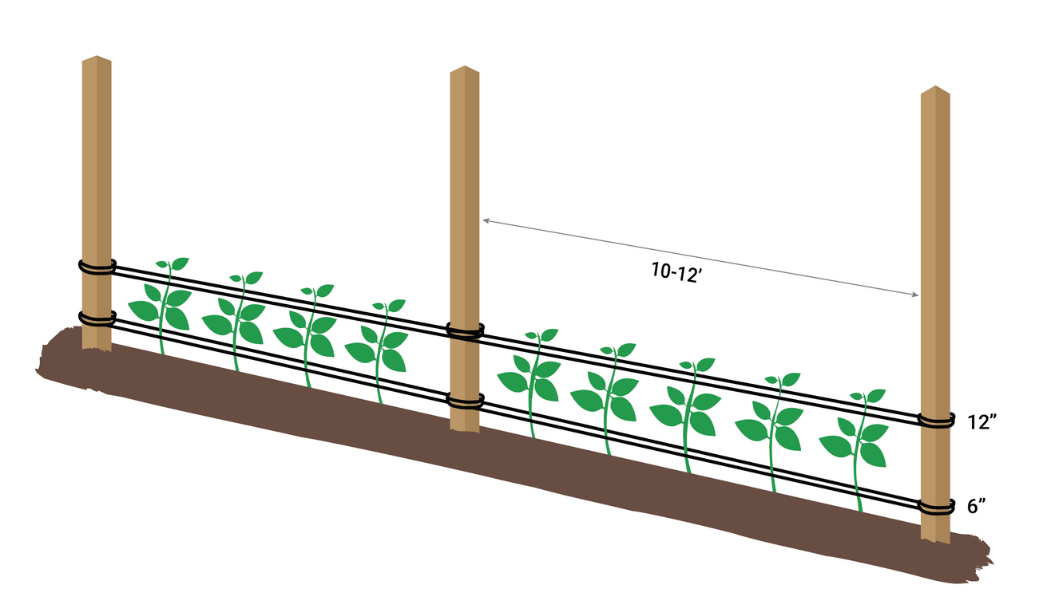
At the Johnny's Research Farm, we use stakes and twine to trellis our pole beans.
It is best to plan your trellis before you plant. There are a few options for trellising:
- Steel or wood fence posts spaced 10–12' apart. When bean plants are 6" tall, start running twine down one side of the row, wrapping around each post, to the end of the row. Then come back up the other side, in the same way. Repeat as beans grow taller, at 12" intervals up the posts (see diagram).
- Also a popular option, use steel or wood fence posts spaced 10–12’ apart and staple or tie Hortonova netting along them to further simplify setup.
- For home gardeners, we offer a sturdy 5'-tall Bean Tower. It can accommodate a dozen bean plants, is built to last, and is collapsible for off-season storage.
- Home gardeners can also create their own tepee system, consisting of three poles tied together at the top with twine. We recommend companion-planting crops such as lettuce, parsley, or radishes in the center of your teepee prior to planting your beans to get the most of your space.
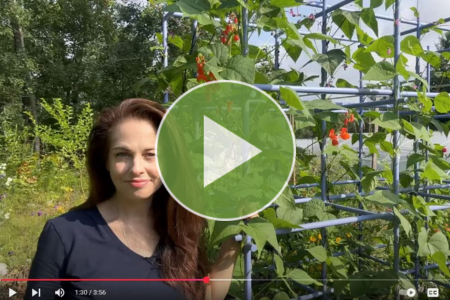
Niki Jabbour uses a variety of trellising methods, including wire mesh panels, tunnels/archways, and bamboo supports. Learn how she grows her pole beans in this video tutorial.
4 Steps to Pole Bean Success
Step 1.
It is best to wait to plant until after the risk of frost has passed, and soil temperatures are consistently above at least 60°F (16°C). Inoculants are not necessary, but can increase yields. Dark seeded beans germinate better in cold soil than white beans. Dark-seeded varieties can be planted as early as April in cooler regions, and will still germinate well.Step 2.
Option A: Cut 1"-deep furrows in the soil, between 60–80" apart. Plant 4–6 seeds/ft, which is spacing the seeds approximately 2–3" apart, no deeper than 1".
Option B: Lay plastic mulch, then jab-plant 3 seeds every 8" through the plastic. This method, which is fast and gives a good stand, is how we plant at the Research Farm in Albion, Maine. (In their home gardens, though, many of Johnny's bean experts favor Option A.)
Step 3.
Install your trellis over well-weeded ground. For commercial growers using bare-ground production, a close tractor cultivation before installing the posts will help with weed control later. Weeds can alternatively be discouraged by laying plastic or bio-mulch prior to planting.
Step 4.
Beans respond very well to drip irrigation in dry conditions. Drip irrigation saves water and effectively assists in the prevention of foliar diseases in your pole beans. Deep-cycle irrigation is preferable to short, numerous irrigations, because the latter can promote soil disease on stems and roots, such as Pythium damping-off pathogens (which are most prevalent in wet and cool conditions).
For additional growing instructions, review our Pole Beans • Key Growing Information
Succession Planting
Growing pole beans can be a very satisfying occupation, as the plants can yield over a fairly long harvest period. Even so, you can get a nice succession and even more continuous supply by planting a new block every few weeks throughout the planting season. Use our Succession Planting Calculator (xlxs) to calculate recommended planting dates based on your estimated first fall frost and the days to maturity of the varieties you will be planting.
High Tunnel/Greenhouse Production
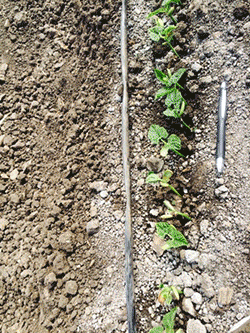
Phil Foster Ranches' Pinnacle Organic Produce (located in San Juan Bautista & Hollister, California) is a leading example for commercial pole bean production. Managed by Phil and Katherine Foster, Pinnacle Organic Produce has developed quite a following for their beans.
They plant pole beans in late January; they grow their 'Northeaster' beans under cover in the early season, just to give the crop some extra heat. They move outdoors for April sowings, saving the tunnels for crops such as tomatoes. Once the warm season is over, however, they move back into the tunnels for a few sowings in August and September, with picking finishing in December.
Of course, this is in California—in New England, in contrast, we rarely would plant before May, even in an unheated tunnel, as it is best to wait to plant until after the risk of frost has passed, and soil temperatures are consistently above at least 60°F (16°C).
As Phil and Katherine demonstrate, high tunnel or greenhouse production can be an effective growing method, because it allows you to start much earlier and go very late into the fall. In rainy climates, it also allows to you keep the vines dry and minimize plant diseases.
Companion Planting in the Home Garden
Pole beans may also be companioned with the traditional bean "sisters," corn and squash (or another cucurbit, such as cucumbers). You can plant three bean seeds or so at the base of a corn plant when the cornstalk is about a foot high, and the beans will climb the corn while the cucurbit vines spread outward and upwards. Intercropping using this method in the field is another option, both for the commercial and home gardener.
Nate's Recommended Pole Bean Varieties

'Fortex' pole beans
Nate Gorlin-Crenshaw, Product Manager at Johnny's has this to say about his favorite pole bean varieties:
'Fortex' is one of my favorite varieties to grow in trial every year. With its unique length and how slow it is to get tough, it’s truly a unique variety. What makes 'Fortex' so nice is its rich, slightly sweet, "beany" flavor. For people looking for a more “traditional” snap bean, I recommend 'Seychelles'; it’s early, vigorous, and the fruit are borne in clusters which make harvesting very easy. Try them both, and decide which does best for your farm or garden.


